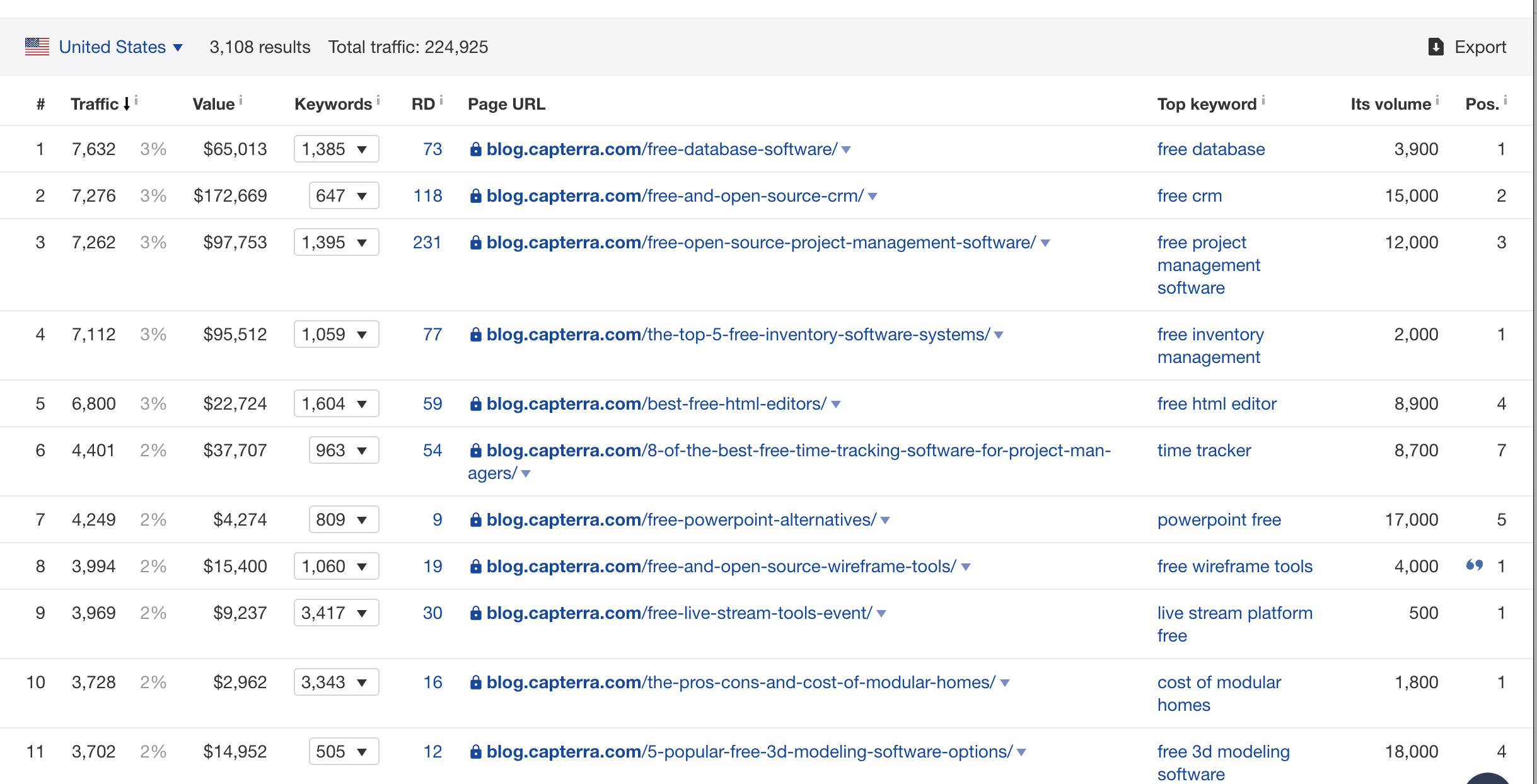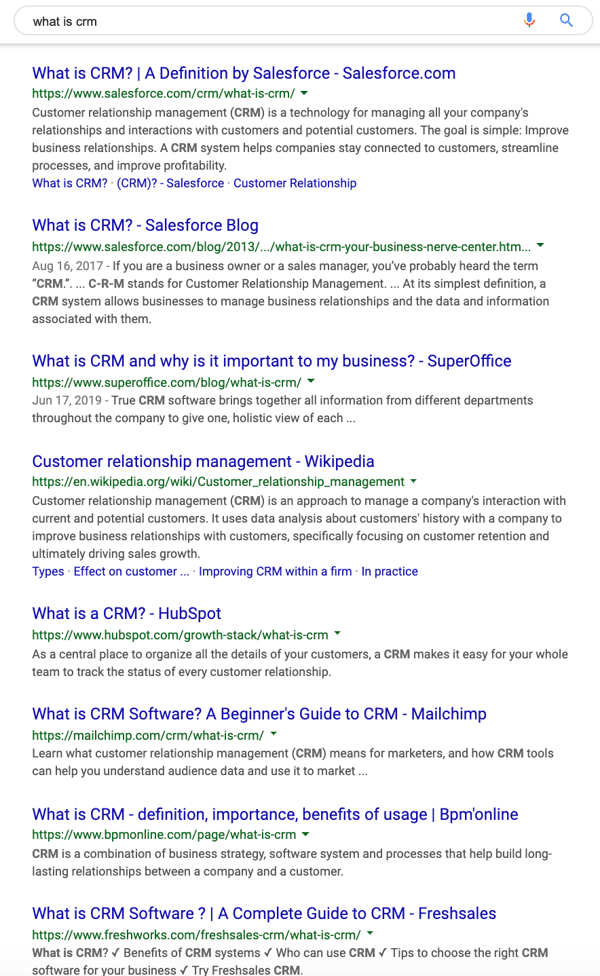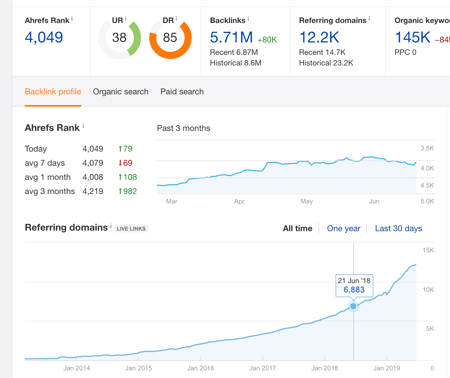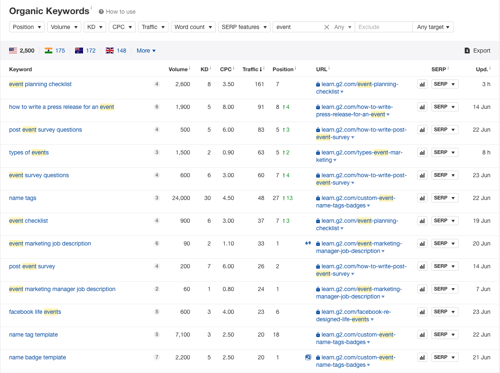In the span of a year, G2’s blog went from a lightly trafficked domain with little direction to a traffic-generating machine.
For more than two years, we invested heavily in building out blog content with little direct effect on organic traffic. For the first nine months of 2017, our monthly blog organic traffic ranged from 3,000 to 5,000 sessions. In December 2017, we had 6,800 organic visitors. In March 2018, there were 50,381 organic sessions to our blog.
In March 2019, the G2 Learning Hub had 991,748 organic sessions.

We didn’t get everything right. Frankly, if we knew in early 2017 what we know today, we’d do a lot of things differently. And as a content marketing team there are still a lot of things we’re learning.
But if there’s one thing we know how to do, it’s this: We know how to bring organic traffic to a blog. A lot of it.
So the team decided to sit down and write this series as a guide so content people everywhere can hopefully learn from what we’ve done (and, let’s be honest, to brag a little bit). So here it is: The story of how G2 attracted 1 million monthly organic blog sessions in one year.
| This is part 1 of The Road to 1M Organic Visits: A Content Marketing Case Study |
Really, this is two separate questions:
For G2, our blog, now our Learning Hub, serves many purposes:
Essentially, our core site (www.g2.com) already drives lots of traffic because it ranks well for hundreds of thousands of keywords. But most of those include the word “software” or are specific software products. With our Learning Hub, we can find people who use software, and may need more/new software, who are searching Google for other things.
And why organic traffic? We still care about other sources; we spend time and energy on social media, creating email campaigns, and many more, but no source is more powerful or repeatable than Google. People are looking to Google first more often than not for their information, so we have to meet them where they are.
Finally, organic traffic more than any other source is a “moat” for our company. Rankings can change, yes. Google can update its algorithm (or simply use your content on its pages). But people aren’t going to stop using Google any time soon, and when you’re getting hundreds of thousands, or even millions, of visitors every month from Google, it’s really difficult for a competitor to take that away from you. It’s a moat, a safeguard for your business.
These are the reasons we care about our Learning Hub and why organic traffic is such a huge focus to our company.
For years, our teams wrote hundreds and hundreds of blog posts and used little quantitative data in how we decided what was written or how it was written. We created a lot of high-quality content, but most of the article ideation process was with the perspective of, “Is this topic interesting?” rather than, “Is there an audience for this via Google?”
The first step in building organic traffic was using SEO software (for us it was Ahrefs) to determine whether any blog topic we write has a keyword volume (how many times a word or phrase is searched monthly on Google) worthy of our time.
No matter what else you do, keyword research is far and away the most important step to getting organic traffic to your blog. If nobody is searching for what you’re writing, nobody is going to find it.
Nothing urges a company into action more than falling behind a competitor, and that’s really the impetus behind this journey to 1 million organic visitors.
We’d invested big resources into writing blogs, but had seen little return from it. On the other hand, our competitors were seeing massive traffic and backlink gains from their own blog content. We were charged with figuring out what those competitors were doing, replicating it, and then, ultimately, doing it better and beating them.
So where do you start for keyword research? We went straight to the source of our problem: If our competitors were beating us so badly, what had they figured out?
Ahrefs offers a great feature where you can look at an entire website or subdomain and see exactly what its best-performing pages are. Here’s Capterra’s blog today. It’s virtually the same as it was 18 months ago:

Turns out that people want software, they just don’t want to pay for it (duh). So the first things we wrote were “Free [software type]” articles. More on how we got traffic to those articles later, but we did and still do. But realistically, there are only so many lists of free software posts we can write. Other competitors gave us additional, topic ideas, but really not too many. So where do you go for other inspiration?
Our CMO, Ryan Bonnici, is a HubSpot alumni and was hired at the earliest stages of our content metamorphosis. HubSpot revolutionized the inbound marketing strategy, and Ryan was the reason the content team and entire company began thinking bigger (significantly bigger) about our content and traffic ambitions.
So why does that matter? Again, we went directly to the source. If HubSpot is the best at building blog traffic, we should figure out what they’re doing. Turns out they were doing a lot right.
Here is HubSpot’s blog profile on Ahrefs. It didn’t look too dissimilar a year ago.

Below is Capterra’s profile. This realization put our mission into perspective. We could beat our competitors with hundreds of thousands of organic visitors. But our real traffic potential is 10x (100x?) that.

Essentially what we learnt was that your company competitors and your content competitors are not always the same.
When you look through search results, look through who it is that published the articles. For some terms, it is all the same industry. But for others, particularly educational content, it’s publishers with different goals.

Of course for “What is CRM” there are CRM software vendors. But there’s also an email marketing vendor. And Wikipedia.
If you’re anything like us, you may realize that your biggest content competitor is the site your professors and teachers warned you not to use.
So, the keyword isn’t dead (but keyword stuffing is). I told you that you can’t ignore the keywords. But that will only get you so far. We haven’t figured everything out SEO-wise, and I also don’t think we’re doing anything particularly groundbreaking in these areas. But we read every blog we can about on-page SEO and link-building, we spend a lot of time and headspace on these two topics, and we ensure everyone creating content at G2 knows how to do each.
The number one area we trailed our competitors in one year ago was in backlinks and referring domains to our site. But in a year we’ve grown dramatically here, essentially doubling referring domains over that time period.

What did we do? At a high level, we put a dedicated team together to build links for the first time ever. Twenty months ago, nobody at G2 spent their workday acquiring links. Today, the team is seven, working in various capacities.
The team built out their linkbuilding strategy in detail, so I won’t go through it all here. But we approached backlinks with the same mindset we approached content: We analyzed our content competitors’ websites. We figured out why people linked to some articles but not to others (stats and graphics are good). We read every single outreach article we received, laughed at a lot of them, but also dissected the good ones.
Today we not only have our backlink team, but all of our writers do some amount of outreach themselves. They know their content best, and they come up with tactics we never would have tried. More importantly, they develop relationships in the areas where they’re writing, and perhaps nothing is more important in building backlinks that creating real relationships.
We’ve all been asked for a link from someone we’ve never heard of who will never talk to us again. I guarantee you’re more likely to include a link to a friend’s resource, or even one of your online-only acquaintance who likes some of your tweets. So build meaningful relationships and don’t just ask, work together with other content creators. It takes extra time, but it will matter to your long-term success.
This is an area where we knew so little when we started out, and it’s perhaps the hardest area for writers to grasp if it’s new to them. SEO best practices change with Google’s algorithm, and even the experts can’t come to a consensus. Turns out, that’s hard for writers used to having the rigidity of an AP Style book at their fingertips.
But it’s possible to figure out, and it’s more than worth the time and energy. Our team go-to SEO expert is Jordan Wahl. One year ago she wasn’t on the content marketing team at G2, she was working with our PR and brand teams. For her first blog she told me she wasn’t a good writer (she was wrong). She didn’t know a thing about SEO.
She was, however, eager to learn about it. Instead of talking about alt text and featured snippets, I talked to her about use intent – the “Why” of SEO rather than the “How.” That resonated with her.
She, too, wrote a more intensive guide to our SEO strategy. It’s the playbook we used to train all of our new writers. It works: A writer on our team who started three months ago knows more about how to get featured snippets than I did a year ago.
Our general learnings, however, are these:
Do everything with your reader in mind. We tell our writers all the time, “Create the best piece of content on the internet for your search term.” If you write the best guide, Google will reward it. If people stay on your page, click your links, come back to your post, Google knows it and moves you up rankings.
When we first started this strategy, we again focused on “free software” terms. Those worked really well. Imagine our excitement when our 6k-monthly visitors doubled in one month because of one blog post (the first one was about free databases).
What we didn’t realize was it wasn’t always going to be that easy.
In hindsight, we realized that we ranked almost overnight for these terms because G2 already ranks for thousands and thousands of terms that include “software.” To Google, these topics were a natural fit to G2 and we were already one of the leading experts in software across the internet.
When we moved to top-of-funnel, less software-adjacent terms, it was far less easy.
By early 2018 we had found hundreds of high-volume terms that were pretty closely related to software. “Social media,” “case studies,” “press releases” – these were the types of topics we dove into.
They did not rank overnight. They did not generate traffic for months and months.
One of our most senior writers helped us stumble on it by accident. She was assigned a pillar page on event marketing, an area she’d worked in previously. Because of her personal knowledge and thoroughness, she ended up with more than 20,000 words on event marketing. So instead of launching one massive, never-going-to-get-read article, she broke it into 10 more manageable chunks, each with its own targeted keyword.
It worked.
Within a few months we were ranking for hundreds of event-related terms. We haven’t written much on events since, and we still rank for 2,500 terms that include the word “event,” and these articles generate tens of thousands of organic visits every month.

From this we started writing more articles on related subjects rather than bouncing around to the biggest terms. We wrote on some smaller topics with lower difficulty so we could generate traffic to articles in the same area. From our experience, reinforced by similar articles, Google rewards topic expertise greatly.
Now, our writers stick to a single topic for roughly three months, writing 20-to-40 pieces of content on anything from business development to website building. We refresh this content semi-regularly and add content when we discover an article we missed or find a new angle to take. We rank for keywords and generate traffic faster than ever before, and we credit clustering our topics as a major contributor.
As I said in the beginning, we’re getting pretty darn good at generating organic traffic. But we’re also still learning a lot of other things.
The first 1 million organic visits largely came from content written between July 2018 and December 2018 by a team of seven content marketers, with contributions from our research team as well. Essentially, the workloads of about 10 full-time writers and four linkbuilders generated 1 million organic visits with six months of content.
So we streamlined our processes and hired more people. In December 2018 we published 75 articles on our Learning Hub. We’re now publishing more than 200 pieces of content per month. The traffic from that content growth has yet to be realized, but we have no reason but to expect it to grow even faster than it did last year.
Now our biggest question is, what do we do with all these visitors.
So while our content creation engine is churning, these are our current challenges:

Finally, written content is just the start. Podcasting has never been more popular, as 51 million Americans have listened to a podcast. We’re going to move into video in the near future (as our CEO Godard Abel reminds us constantly, video is the future [at least part of it]).
We’re planning more original studies. Our research team is writing about technology trends. We have developed a contributor network. We’re testing other types and formats of content.
In short: We’re not done, and we’re always looking for new ways to get better and increase the scope of our mission. We intentionally hired content marketers from different backgrounds so we could have as many voices in the room as possible.
Content marketing does not have a one-size-fits-all playbook, and it is changing every year. This playbook worked well for us in 2018 and 2019. We plan to keep adapting it as we go.
Ahrefs starts at $108 a month, which adds up to about $1,200 a year for a plan designed for...
 by Sudipto Paul
by Sudipto Paul
You know that feeling when you’re asked “What do you want for dinner tonight?” and you’re...
 by Holly Hunt
by Holly Hunt
Let’s face it – building solid traffic numbers isn’t easy nor can it be done overnight.
 by Jordan Wahl
by Jordan Wahl
Ahrefs starts at $108 a month, which adds up to about $1,200 a year for a plan designed for...
 by Sudipto Paul
by Sudipto Paul
You know that feeling when you’re asked “What do you want for dinner tonight?” and you’re...
 by Holly Hunt
by Holly Hunt


